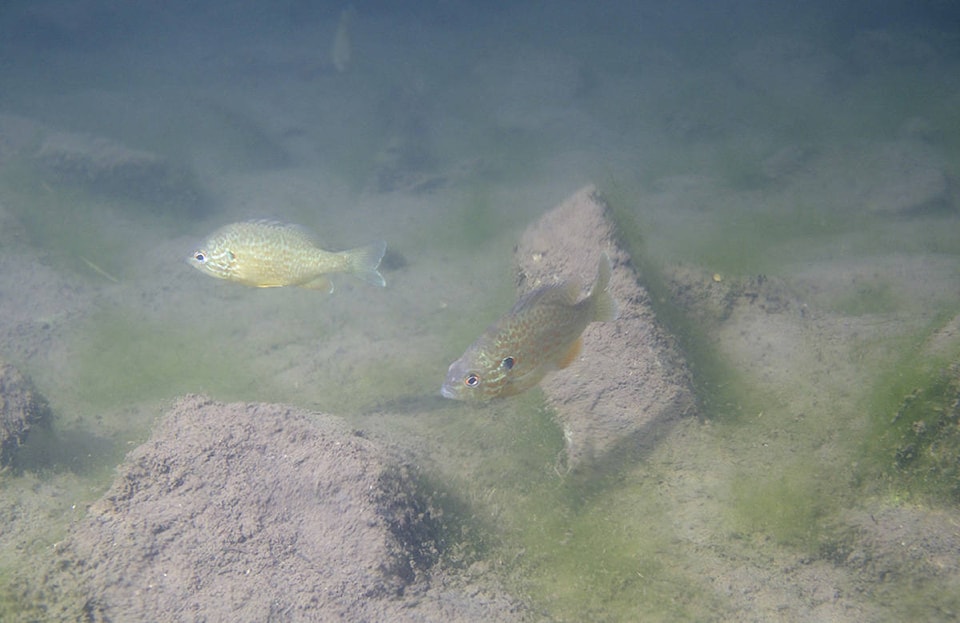Imagine delicately dipping your toes into a steaming pool of geothermal water — and seeing a live fish, only a few steps away.
That’s what I saw in mid July, when my wife and I took a stroll out to the Harrison Hot Springs Hotel’s mineral water intake, west of the hotel.
A sign at the pavilion warns, “Do not climb fence. Water extremely hot. Above 140 degrees (Fahrenheit.)”
To the west of the intake, a pipe carries overflow into a small pond, where the public can step in, up to mid-calf where the hot water meets the cooler water of the pool. This is where I saw the fish. On closer inspection, I saw there were actually many more, of varying sizes.
Not having my camera with me, I vowed to come back and take some photos so I could identify these amazing creatures. They looked tropical, with a fluorescent green flash on their tails. They also looked like something I had seen at Christina Lake, near Grand Forks, “Canada’s warmest tree-lined lake.”
On my next trip, the lighting wasn’t good enough and photos weren’t print worthy. I’d have to bring more gear, though it wasn’t all a wasted trip.
Seated by the outlet was a fellow named Edward, who said he’d been coming to the pond for about 40 years. He couldn’t recall when he started noticing the fish and was struggling to recall what other passersby had called them. Then Rose Anderson of Chilliwack came by and identified them as tropical fish named cichlids (pronounced “sick-lids”).
“That’s it!” said Edward, smiling.
I learned weeks later, they were both wrong on the species… though Edward was right about how they could survive in such hot water. “It’s the layer effect,” he explained.
When I put my household thermometer in the outlet water, the reading quickly shot to its 50º Celsius maximum, suggesting the outlet temperature would easily be in the 70-80º range.
Scalding hot.
A few steps away, the surface was still hot — but when I put the thermometer on the bottom of the pond, it dipped down to 32º C. (Shoreline lake temperature that day was 22º C.)
I stepped into the deeper water and felt the science behind Edward’s claim. My feet and lower calves were reasonably cool, while the surface water was burning narrow rings of fire around my upper calves. Having a lighter density, the hot water will not readily mix with the cooler liquid until it cools, farther out in the pond. Lake water, seeping under the causeway, has a moderating effect on the hot springs water.
Watching the fish, they were always careful to stay away from the surface, unless well away from the hot springs outlet.
For my third visit, last Friday, I bought a small fish tank, so I could put my camera inside it, while still having Wi-Fi control of the camera and off-camera flash. The $20 tank served as a poor man’s underwater housing, sort of like a glass-bottomed boat. Using the camera’s RAW setting allowed much more control of the post-processing, producing more detail when combined with the flash.
Rather than being spooked, the fish seemed interested in the strange contraption and stuck around for lots of shots. The biggest of the bunch were about 8 to 10 cm… half the potential maximum.
Armed with my evidence, I checked with Brian Brosseau, of Shallow Water Tropical Fish, on Young Road in Chilliwack.
“Those aren’t cichlids, he declared. They’re pumpkinseed sunfish.”
He allowed that they looked a bit like cichlids but the black dot and the red slash behind the gills — and the pumpkinseed pattern on their sides were dead giveaways.
“They’re endemic to Ontario, where I grew up but they’re not endemic to this area. Somebody must have introduced them,” said Brosseau.
Indeed, the Department of Fisheries and Oceans’ website says the species was introduced to Columbia River waters in the early 1900s. “This species was introduced for different purposes, including control of other fish populations and as forage for predatory species such as largemouth bass.
“Non-native Pumpkinseed is also found in several lakes on Vancouver Island as well as the lower Fraser Valley.”
Make that the upper Fraser Valley now. With their optimum water temperature being 24 to 32º C, these Harrison sunfish have it made in the shade — even in the winter, when they can cuddle up a little closer to the hot springs outlet.
